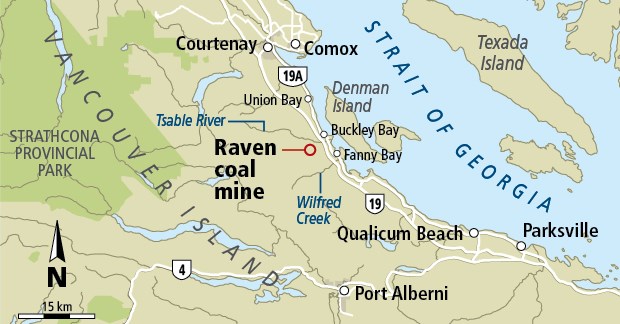Opponents of the proposed Raven coal mine near Courtenay are celebrating after the B.C. government pulled the plug on the controversial project.
The province terminated the mine’s environmental assessment this week after Compliance Energy Corp. failed to submit the information required by government officials.
The move ended a process that began in mid-2009 amid fears that the mine would contaminate watersheds, threaten wildlife and harm shellfish growers in Baynes Sound.
Roberta Stevenson, executive director of the B.C. Shellfish Growers Association, said Thursday that she was “delighted” by the decision to terminate the assessment, but frustrated that it took so long to arrive.
“Why did I have to wait six and a half years for an answer?” she said. “The writing was on the wall years ago. The public opposition was intense. The support for the farming community was immense. And yet we still don’t hear for six and a half years.”
Kevin Jardine, executive director of the environmental assessment office, stated in a letter to Compliance this week that he was unaware of any efforts since March 2015 to advance the project.
“To be clear, this decision to terminate the [environmental assessment] is not a reflection of the Raven project or the potential effects related to the project,” Jardine stated in the letter to former Compliance chairman James O’Rourke. “It is based on an assessment that continuation of an [environmental assessment] at this time would be neither efficient nor appropriate given the time and readiness of the project to proceed with the [assessment].”
O’Rourke said Thursday that he had yet to see the letter and had no comment on the government decision.
“All of the directors and officers have resigned,” he said. “So I’m not really involved in it.”
Compliance announced in February that the company was effectively insolvent and that all directors had stepped down. It blamed the “protracted” environmental assessment process for the withdrawal of key investors and the company’s inability to raise more money.
But Liberal MLA Don McRae, who represents Comox Valley, said the company had a long time to meet the test and failed.
“I think it’s always easier to put the blame somewhere else,” he said. “I know that the file was inactive for a very long period of time. … So while I’m sure government can always do a little better, I’m sure in this particular case the company could have done much better as well, and they didn’t.”
John Snyder, president of CoalWatch, said Compliance twice failed to submit the information required by the environmental assessment office. The company never made it past the initial screening in May 2013, before reapplying for an environmental assessment certificate in February 2015.
“They kind of had two bites at the apple, but they just didn’t come through,” he said.
Snyder said the decision will come as a relief to the many opponents of the project.
“I think the fact it’s finally been put to bed is a positive sign and we can move forward,” he said. “But the coal resource still remains in the ground, so as residents here, we’re going to have to still continue to be vigilant.”
Compliance Energy had planned to extract 1.1 million tonnes of coal per year during peak production, with trucks or trains carrying the product to Port Alberni for shipping to steel-making markets in Japan and South Korea.
The company said in 2012 that the project would contribute $1.1 billion to local economies and create about 350 full-time jobs in the Comox Valley and Port Alberni over the 16-year life of the mine.



